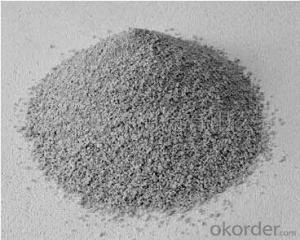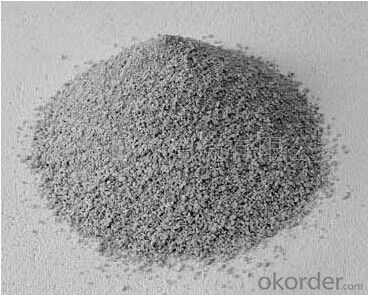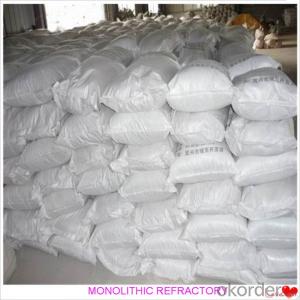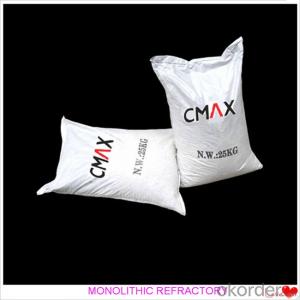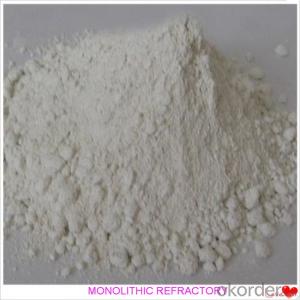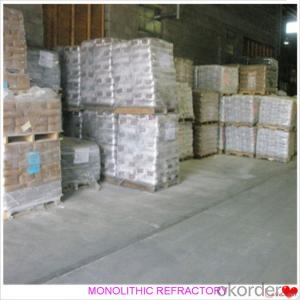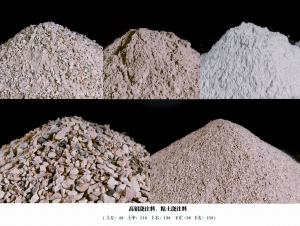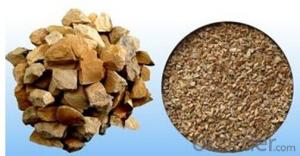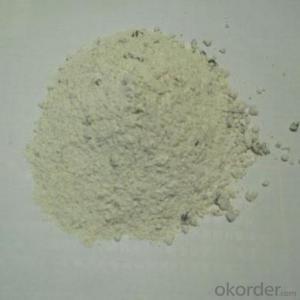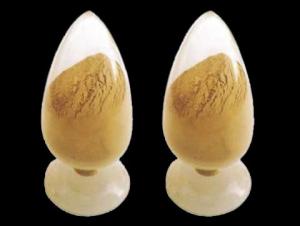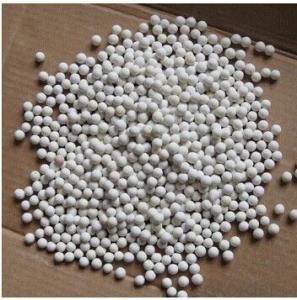Monolithic Refractories for Iron and Steel Industry:Mullite Heat Insulating Castable
- Loading Port:
- China Main Port
- Payment Terms:
- TT OR LC
- Min Order Qty:
- -
- Supply Capability:
- -
OKorder Service Pledge
OKorder Financial Service
You Might Also Like
characteristic:
construction convenient
using for furnace lining
wear-resistant,flame-proof
| Item | | insulating castable | ||||||
| JNL-45 | JBN-40 | JGL-85 | JGL-70 | JDL-80 | JLL-75 | JLL-60 | ||
| Al2O3 % | 45 | 40 | 80 | 70 | 80 | 75 | 60 | |
| CaO % | — | — | — | — | 2.5 | — | — | |
| Refractoriness °C | 1700 | 1670 | 1790 | 1750 | 1790 | 1790 | 1750 | |
| Linear change affter sintered ≤±1% | 1350°C ×3h | 1000°C ×3h | 1500°C ×3h | 1450°C ×3h | 1500 °C ×3h | 1500°C ×3h | 1450°C× 3h | |
| 110°C±5 After drying | Crushing strength Mpa | 8 | 20 | 35 | 30 | 40 | 30 | 25 |
| Modulus rupture Mpa | 1 | — | 5 | 5 | 6 | 5 | 4 | |
| Bonder | clay | water glass | cement | cement | lower cement | phosphate | phosphate | |
High-strength lightweight Insulating refractory castable
1. low bulk density, low thermal conductivity, high intension.
2. good integrity and excellent air impermeability.
3. be used as cover of warm or low- temperature heat engineering equipments
4. It can also be thensulating material in hot temperature furnace.
5. way of usagre: daubing or casting.
The index is as follows:
- Q: How do monolithic refractories help in enhancing the durability of iron and steel furnaces?
- The durability of iron and steel furnaces is greatly improved by the use of monolithic refractories, which possess unique properties and characteristics. These materials are specifically designed to endure harsh conditions and extremely high temperatures, making them the ideal choice for lining furnaces. To begin with, monolithic refractories exhibit exceptional thermal resistance, enabling them to withstand extreme heat without compromising their structural integrity. With iron and steel furnaces operating at temperatures exceeding 2,000 degrees Celsius, traditional bricks or other materials would quickly succumb to such intense heat, necessitating frequent repairs and maintenance. Conversely, monolithic refractories are capable of enduring these extreme temperatures without deterioration, thereby enhancing the durability of the furnaces. Furthermore, monolithic refractories boast a high resistance to chemical attack. In the production of iron and steel, the materials being processed often contain impurities and aggressive chemicals that can react with the furnace lining, leading to corrosion and erosion over time. However, monolithic refractories possess a remarkable ability to resist chemical attack, ensuring that the lining remains intact and durable even in the presence of corrosive elements. In addition, monolithic refractories exhibit superior mechanical strength and abrasion resistance. The movement of raw materials, stirring of molten metal, and tapping of the furnace exert mechanical stress and cause abrasion on the lining. Consequently, the lining must withstand this constant wear and tear without cracking or breaking. Monolithic refractories possess exceptional mechanical strength and can resist abrasion, thereby guaranteeing the durability and functionality of the furnace for an extended period. Moreover, monolithic refractories offer outstanding thermal shock resistance. The lining of iron and steel furnaces experiences rapid temperature changes during various stages of production. These temperature fluctuations induce thermal stress and may result in cracks or spalling of the lining. However, monolithic refractories possess low thermal conductivity and can endure thermal shock, effectively preventing any damage to the furnace lining and enhancing its durability. In conclusion, monolithic refractories contribute significantly to the durability of iron and steel furnaces by providing excellent thermal resistance, high resistance to chemical attack, superior mechanical strength and abrasion resistance, as well as exceptional thermal shock resistance. These properties ensure the integrity of the furnace lining, enabling it to withstand extreme temperatures and resist the corrosive and abrasive nature of the materials being processed. Ultimately, this prolongs the lifespan of the furnace and reduces the necessity for frequent repairs or replacements.
- Q: What is the role of monolithic refractories in blast furnaces?
- Monolithic refractories have a crucial function in blast furnaces, as they offer high-temperature resistance and excellent durability in the furnace's harsh operating conditions. Blast furnaces are utilized in the ironmaking process to transform iron ore into molten iron, and monolithic refractories are essential for lining the furnace's interior. Withstanding extreme temperatures is one of the main purposes of monolithic refractories in blast furnaces. The furnace's interior can reach temperatures as high as 2,500 degrees Celsius, and monolithic refractories are specifically designed to preserve their structural integrity and shield the furnace lining from thermal shock and erosion caused by these high temperatures. Monolithic refractories also provide insulation, preventing heat loss from the furnace. This is significant as it helps to maintain the desired temperature for efficient iron production. By minimizing heat loss, monolithic refractories contribute to energy conservation and improved overall furnace performance. Another critical role of monolithic refractories is to resist chemical attack from the molten iron and slag. The materials employed in blast furnaces, such as iron ore, coke, and limestone, undergo various chemical reactions during the ironmaking process. Monolithic refractories are engineered to withstand the corrosive effects of these reactions, ensuring a longer lifespan for the furnace lining. Furthermore, monolithic refractories offer exceptional mechanical strength and resistance to abrasion. The materials processed in a blast furnace, including iron ore and coke, can be abrasive. Monolithic refractories act as a protective barrier against this abrasive action, preventing damage to the furnace lining and extending its lifespan. In conclusion, the role of monolithic refractories in blast furnaces is to endure extreme temperatures, provide insulation, resist chemical attack, and offer mechanical strength against abrasion. These properties contribute to the efficient operation and longevity of blast furnaces, enabling the production of molten iron for various industrial applications.
- Q: How do monolithic refractories contribute to the overall efficiency of ladle slagging operations?
- Monolithic refractories play a crucial role in improving the overall efficiency of ladle slagging operations. Ladle slagging is a process that involves the removal of impurities from molten metal in a ladle before it is poured into molds or further processed. One of the key contributions of monolithic refractories is their ability to withstand high temperatures, which is essential in ladle slagging operations. The refractory lining of the ladle needs to be able to endure the extreme heat generated by the molten metal and slag, as well as the chemical reactions occurring during the process. Monolithic refractories, with their high thermal stability, prevent the lining from cracking or deteriorating, thus ensuring the integrity of the ladle and maintaining its efficiency. Additionally, monolithic refractories offer excellent resistance to chemical erosion and corrosion. During the ladle slagging process, the molten metal and slag can contain various impurities and aggressive chemicals, such as sulfur, phosphorus, and other oxides. These substances can attack and degrade the lining of the ladle, compromising its efficiency. However, monolithic refractories are designed to resist these chemical attacks, thereby extending the lifespan of the ladle and reducing the need for frequent repairs or replacements. Moreover, monolithic refractories provide good thermal insulation properties. Ladle slagging operations require precise temperature control to ensure the desired chemical reactions and efficient removal of impurities. The thermal insulation offered by monolithic refractories helps to maintain a consistent temperature within the ladle, preventing heat loss and allowing for optimized slagging conditions. This insulation also minimizes energy consumption and improves the overall energy efficiency of the ladle slagging process. In conclusion, monolithic refractories contribute significantly to the overall efficiency of ladle slagging operations. Their ability to withstand high temperatures, resist chemical erosion, and provide thermal insulation ensures the integrity and longevity of the ladle. By reducing the need for frequent repairs and allowing for precise temperature control, monolithic refractories optimize the slagging process, leading to improved productivity and cost-effectiveness.
- Q: What are the key differences between acidic and basic monolithic refractories?
- The key differences between acidic and basic monolithic refractories lie in their chemical compositions and their behavior in different environments. Acidic monolithic refractories are primarily composed of acidic oxides such as silica (SiO2) or alumina (Al2O3). These materials have a high resistance to acidic environments and are commonly used in industries where they come into contact with acidic gases or liquids. Acidic refractories are characterized by their ability to withstand high temperatures and resist chemical erosion. They are generally not suitable for use in basic or alkaline conditions, as they can react with basic compounds and lose their effectiveness. On the other hand, basic monolithic refractories are composed of basic oxides such as magnesia (MgO) or dolomite (MgO-CaO). These materials have a high resistance to basic or alkaline environments and are commonly used in industries where they come into contact with basic compounds such as lime or cement. Basic refractories are characterized by their ability to withstand high temperatures and resist chemical erosion from basic compounds. They are generally not suitable for use in acidic conditions, as they can react with acidic compounds and lose their effectiveness. In terms of their physical properties, acidic monolithic refractories tend to have higher melting points and better thermal shock resistance compared to basic monolithic refractories. This is due to the higher melting points of acidic oxides and their ability to form stable silicate or aluminate structures at high temperatures. On the other hand, basic monolithic refractories generally have higher density and better resistance to penetration by molten materials. In conclusion, the key differences between acidic and basic monolithic refractories lie in their chemical compositions and their behavior in different environments. Acidic refractories are suitable for acidic conditions, have higher melting points, and better thermal shock resistance, while basic refractories are suitable for basic conditions, have higher density, and better resistance to penetration by molten materials.
- Q: How do monolithic refractories contribute to the reduction of heat loss in ladles and tundishes?
- The use of monolithic refractories is crucial in reducing heat loss in ladles and tundishes. These refractories are designed to have excellent thermal insulation properties, which effectively minimize the transfer of heat from the molten metal to the surrounding environment. Conduction is a key factor that contributes to heat loss in ladles and tundishes. It occurs when heat is transferred through direct contact with the refractory lining. However, monolithic refractories are specifically engineered to have low thermal conductivity, making them efficient in reducing heat transfer through conduction. This, in turn, helps to maintain the desired temperature of the molten metal for longer periods, resulting in lower energy consumption and improved process efficiency. Additionally, monolithic refractories also aid in reducing heat loss through radiation. They have high emissivity, meaning they emit a significant amount of thermal radiation. This emitted radiation creates a heat shield around the molten metal, preventing heat loss to the surroundings. By effectively trapping the radiant heat, monolithic refractories contribute to maintaining the desired temperature in ladles and tundishes, minimizing heat loss. Apart from their thermal insulation properties, monolithic refractories also offer excellent resistance to thermal shock and mechanical stress. This ensures that they remain intact and functional even in the harsh operating conditions of ladles and tundishes. The durability of these refractories further contributes to the reduction of heat loss by preventing any cracks or gaps in the refractory lining that could facilitate heat transfer. To summarize, monolithic refractories play a significant role in reducing heat loss in ladles and tundishes by minimizing heat transfer through conduction and radiation. Their thermal insulation properties, combined with their resistance to thermal shock and mechanical stress, help to maintain the desired temperature of the molten metal, improve energy efficiency, and enhance the overall performance of these metallurgical vessels.
- Q: How do monolithic refractories prevent heat loss through radiation?
- Monolithic refractories prevent heat loss through radiation by their high thermal conductivity and low thermal expansion. These properties allow them to efficiently transfer heat from the hot side of the refractory to the cooler side, minimizing the temperature difference and reducing heat loss through radiation. Additionally, monolithic refractories provide a continuous and seamless lining, eliminating gaps and cracks that could allow heat to escape. The dense and compact structure of monolithic refractories also acts as a barrier to prevent radiation heat transfer. Overall, monolithic refractories play a crucial role in maintaining thermal insulation and preventing heat loss through radiation in various high-temperature applications.
- Q: What are the challenges in repairing and maintaining monolithic refractories?
- There are several challenges associated with repairing and maintaining monolithic refractories. One major challenge is the complex nature of the materials used in monolithic refractories. These materials are often a combination of several components, including aggregates, binders, and additives. The selection and proportioning of these components can greatly impact the performance and durability of the refractory, making it difficult to determine the exact repair or maintenance method. Another challenge is the high temperatures at which monolithic refractories operate. These materials are designed to withstand extreme heat, which can range from several hundred to several thousand degrees Celsius. Repairing or maintaining monolithic refractories at such high temperatures requires specialized equipment and techniques to ensure the safety of the workers and the integrity of the repair. Additionally, monolithic refractories are often exposed to harsh environments, such as corrosive gases, chemical reactions, and mechanical stresses. These factors can lead to degradation and damage over time, requiring regular inspections and maintenance. Identifying and addressing these issues in a timely manner can be challenging, as the damage may not always be visible or easily accessible. Furthermore, monolithic refractories are commonly used in complex industrial processes, such as steelmaking, cement manufacturing, and petrochemical production. These processes often involve continuous operation, which limits the time available for repairs and maintenance. Finding suitable windows of opportunity for maintenance and coordinating the shutdowns of these processes can be a logistical challenge. Lastly, the cost of repairing and maintaining monolithic refractories can be significant. The materials used in monolithic refractories can be expensive, and the labor and equipment required for repairs and maintenance can add up. Balancing the cost of repairs with the need to maintain productivity and extend the service life of the refractories can be a challenge for plant operators and maintenance teams. In conclusion, the challenges in repairing and maintaining monolithic refractories stem from the complex nature of the materials, the high temperatures involved, the harsh operating environments, the complexity of industrial processes, and the cost considerations. Overcoming these challenges requires expertise, careful planning, and effective coordination to ensure the longevity and performance of monolithic refractories.
- Q: How are monolithic refractories manufactured?
- Monolithic refractories are manufactured using a specific process that involves several steps. The first step is the selection and preparation of raw materials. These raw materials usually include aggregates, binders, and additives. Aggregates are chosen based on their chemical and physical properties, while binders are used to hold the aggregates together. Additives are included to enhance specific properties of the refractory material. Once the raw materials are selected, they are mixed together in precise proportions to create a homogeneous mixture. This mixture is then blended using various techniques such as dry or wet mixing, depending on the desired characteristics of the final product. After blending, the next step is shaping the refractory material. This can be done through several methods such as casting, gunning, ramming, or spraying. Each method is chosen based on the specific application and requirements of the refractory. Once the refractory material is shaped, it undergoes a curing process. This process involves drying the material at a controlled temperature to remove any excess moisture and allow for the development of desired properties. Finally, the cured refractory material is fired in a kiln at high temperatures. This firing process helps to further strengthen the refractory and enhance its resistance to heat and other harsh conditions. Overall, the manufacturing of monolithic refractories involves careful selection and preparation of raw materials, precise blending, shaping, curing, and firing processes. This ensures the production of high-quality refractory materials that can withstand the extreme conditions found in various industrial applications.
- Q: How do monolithic refractories contribute to energy efficiency in iron and steel manufacturing?
- Monolithic refractories play a crucial role in enhancing energy efficiency in iron and steel manufacturing processes. These refractories are made of a single material, typically a combination of high-quality aggregates, binders, and additives, which allows for easy installation and repair. One of the main ways monolithic refractories contribute to energy efficiency is by reducing heat loss. These materials have excellent insulation properties, which help to maintain high temperatures within the furnace or kiln. By minimizing heat loss, the energy required to maintain the desired temperature is significantly reduced, leading to lower energy consumption and cost savings. Moreover, monolithic refractories are designed to have high thermal conductivity. This property ensures efficient heat transfer from the hot gases or flames to the iron and steel being processed. By facilitating efficient heat transfer, monolithic refractories enable faster heating rates and reduce the overall processing time. This time reduction translates into energy savings and increased production capacity. Another significant advantage of monolithic refractories is their ability to withstand extreme temperatures and harsh operating conditions. These materials have excellent resistance to thermal shock, corrosion, and erosion, which extends their lifespan and reduces the need for frequent repairs or replacements. Consequently, the use of monolithic refractories leads to less downtime, allowing for continuous operation and improved energy efficiency. Furthermore, monolithic refractories offer design flexibility, which enables the optimization of furnace and kiln geometries. By tailoring the shape and dimensions of the refractory linings, heat distribution can be improved, ensuring more uniform heating and reducing energy wastage. The ability to customize the refractory linings also facilitates the implementation of advanced combustion technologies, such as regenerative burners or oxy-fuel burners, which further enhance energy efficiency. In summary, monolithic refractories contribute to energy efficiency in iron and steel manufacturing by reducing heat loss, enhancing heat transfer, withstanding extreme conditions, optimizing furnace geometries, and allowing for the implementation of advanced combustion technologies. By utilizing these refractories, the industry can achieve significant energy savings, cost reductions, and environmental benefits.
- Q: What are the benefits of using monolithic refractories in the iron and steel industry?
- There are several benefits of using monolithic refractories in the iron and steel industry. Firstly, monolithic refractories offer excellent thermal shock resistance, allowing them to withstand extreme temperature changes without cracking or spalling. This is crucial in the iron and steel industry, where materials are subjected to high temperatures during processes like melting, casting, and heat treatment. Secondly, monolithic refractories have superior corrosion resistance, making them highly durable against the corrosive effects of molten metals and slag. This is particularly important in the iron and steel industry, where materials come into contact with aggressive molten iron, steel, and various chemical compounds. Additionally, monolithic refractories provide excellent mechanical strength and abrasion resistance. They have the ability to withstand mechanical stress, vibrations, and impacts typically encountered in the iron and steel industry. This ensures longer refractory lifespan, reduces downtime for repairs or replacements, and improves overall operational efficiency. Moreover, monolithic refractories offer ease of installation and repair. Unlike traditional refractory bricks that require complex and time-consuming masonry work, monolithic refractories can be installed quickly and easily using simple methods like casting, gunning, or spraying. This saves time and labor costs during initial installation and subsequent maintenance or repairs. Furthermore, monolithic refractories provide flexibility in design and application. They can be tailored to specific shapes and sizes, allowing for customized linings in different parts of the iron and steel manufacturing process. This versatility enhances the overall efficiency and effectiveness of refractory linings, optimizing the production output and ensuring consistent quality of the finished iron and steel products. In conclusion, the benefits of using monolithic refractories in the iron and steel industry are numerous. They offer exceptional thermal shock resistance, corrosion resistance, mechanical strength, and abrasion resistance. They are easy to install and repair, and their flexibility allows for customized designs. Overall, monolithic refractories contribute to improved productivity, reduced downtime, and enhanced product quality in the iron and steel industry.
Send your message to us
Monolithic Refractories for Iron and Steel Industry:Mullite Heat Insulating Castable
- Loading Port:
- China Main Port
- Payment Terms:
- TT OR LC
- Min Order Qty:
- -
- Supply Capability:
- -
OKorder Service Pledge
OKorder Financial Service
Similar products
Hot products
Hot Searches
Related keywords
